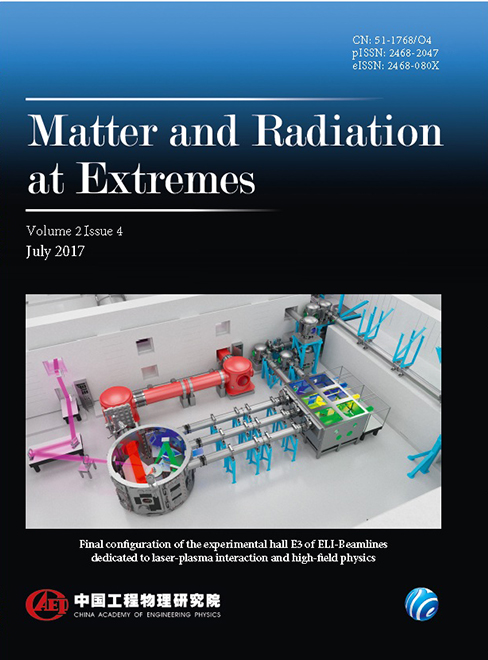
Recently generation of strong magnetic (B) fields has been demonstrated in capacitor coils heated by high power laser pulses [S. Fujioka et al., Sci. Rep. 3, 1170 (2013)]. This paper will present a direct measurement of B field generated with an open-ended coil target driven by a nanosecond laser pulse using ultrafast proton radiography. The radiographs are analyzed with particle-tracing simulations. The B field at the coil center is inferred to be ~50 T at an irradiance of -5×1014 W?cm2. The B field generation is attributed to the background cold electron flow pointing to the laser focal spot, where a target potential is induced due to the escape of energetic electrons.
The equations of state (EOSs) of materials are the cornerstone of condensed matter physics, material science, and geophysics. However, acquiring an accurate EOS in diamond anvil cell (DAC) experiments continues to prove problematic because the current lack of an accurate pressure scale with clarified sources of uncertainty makes it difficult to determine a precise pressure value at high pressure, and nonhydrostaticity affects both the volume and pressure determination. This study will discuss the advantages and drawbacks of various pressure scales, and propose an absolute pressure scale and correction methods for the effects of non-hydrostaticity. At the end of this paper, we analyze the accuracy of the determined EOS in the DAC experiments we can achieve to date.
This paper generally compares the essential features between tokamaks and stellarators, based on previous review work individually made by authors on several specific topics, such as theories, bulk plasma transport and edge divertor physics, along with some recent results. It aims at summarizing the main results and conclusions with regard to the advantages and disadvantages in these two types of magnetic fusion devices. The comparison includes basic magnetic configurations, magnetohydrodynamic (MHD) instabilities, operational limits and disruptions, neoclassical and turbulent transport, confinement scaling and isotopic effects, plasma rotation, and edge and divertor physics. Finally, a concept of quasi-symmetric stellarators is briefly referred along with a comparison of future application for fusion reactors.
In this paper, we give a review of some most powerful pulsed systems developed at the Institute of High Current Electronics (HCEI), Siberian Branch, Russian Academy of Sciences, and describe latest achievements of the teams dealing with these installations. Besides the presented high-power systems, HCEI performs numerous investigations using much less powerful generators. For instance, last year much attention was paying to the research and development of the intense low-energy (<200 kV) high-current electron and ion beam and plasma sources, and their application in the technology [1-3].
Stable neutron generation with a yield of ~1.2×104 neutrons per pulse was obtained during d(d,n)3He reaction initiated by the high-voltage nanosecond discharge in a gap with a potential tungsten cylinder (anode) and a grounded deuterated zirconium plate (cathode) filled with deuterium at a pressure of ~102 Pa. Estimated duration of the neutron pulse was ~1.5 ns. Less intensive neutron emission was registered without deuterated plate. Splashing of material of the tungsten electrode was observed during the high-voltage nanosecond discharge in the deuterium, hydrogen, helium and argon at pressures of 102-104 Pa.
Polymer shells with high sphericity and uniform wall thickness are always needed in the inertial confined fusion (ICF) experiments. Driven by the need to control the shape of water-in-oil (W1/O) compound droplets, the effects of the density matching level, the interfacial tension and the rotation speed of the continuing fluid field on the sphericity and wall thickness uniformity of the resulting polymer shells were investigated and the spherical and concentric mechanisms were also discussed. The centering of W1/O compound droplets, the location and movement of W1/O compound droplets in the external phase (W2) were significantly affected by the density matching level of the key stage and the rotation speed of the continuing fluid field. Therefore, by optimizing the density matching level and rotation speed, the batch yield of polystyrene (PS) shells with high sphericity and uniform wall thickness increased. Moreover, the sphericity also increased by raising the oil/water (O/W2) interfacial tension, which drove a droplet to be spherical. The experimental results show that the spherical driving force is from the interfacial tension affected by the two relative phases, while the concentric driving force, as a resultant force, is not only affected by the three phases, but also by the continuing fluid field. The understanding of spherical and concentric mechanism can provide some guidance for preparing polymer shells with high sphericity and uniform wall thickness.Physics for financial support (2014B0302052) and National Natural Science Foundation of China (U1530260).









